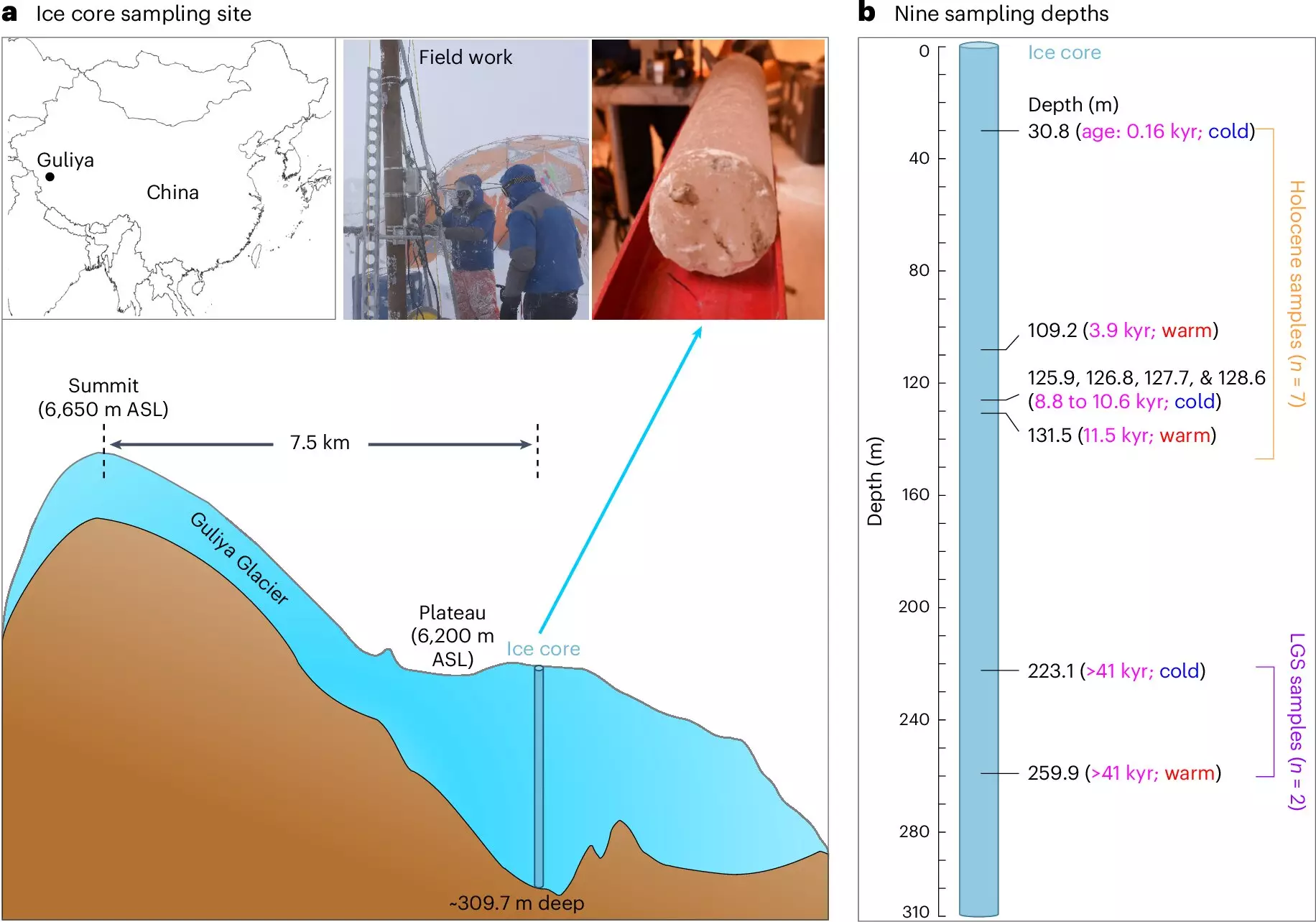The study of glaciers has long been pivotal in understanding historical climate patterns, but a recent focus on ancient viruses within glacial ice might just deepen our comprehension of climate changes. The Guliya Glacier, situated in the remote Tibetan Plateau, offers a compelling narrative where climatology intersects with microbiology. Researchers have recently turned their attention to these ancient microbes, revealing a treasure trove of nearly 1,700 viral species trapped in ice, of which around 75% are newly identified. This examination not only opens up new scientific discussions but also signifies a critical juncture in climate science.
The Guliya Glacier, rising above 20,000 feet in altitude, has been known for decades as a valuable repository for climate-related research. By drilling into its deep ice cores, scientists have managed to resurrect ancient viral DNA, providing a unique opportunity to analyze environmental conditions from thousands of years ago. The glacial layers serve as a temporal record, reflecting climate transitions over the past 41 millennia—from cold periods to warmer interludes. As global temperatures rise and glaciers rapidly retreat, the urgency to understand these preserved ecosystems intensifies, as does the need to explore their implications for contemporary climate change.
The intriguing aspect of this research is its focus on how these latent viruses interacted with their microbial hosts during fluctuating climate periods. Dr. ZhiPing Zhong, a leading scientist in this study, notes that the viral adaptations appear to have influenced host survival strategies in extreme environmental conditions. This connection between ancient viral activity and climate variability suggests that viruses played a significant role in shaping ecological responses during critical shifts in Earth’s climate. Although fears exist regarding the health implications of these ancient microbes, researchers assert that their study primarily pertains to viruses that would have influenced other microorganisms rather than humans or larger animals.
This expansive study reveals that most bacteria and viruses isolated from the Guliya Glacier are unique to this environment, suggesting a complex web of microbial life distinctly adapted to its frigid conditions. However, around a quarter of the identified viral species share genetic similarities with viral strains from disparate regions, including the Middle East and Arctic territories. This observation raises poignant questions about the migration and dispersal of microbial life across climatic barriers. Understanding these dynamics is crucial, as it provides foundational knowledge about how ancient ecosystems functioned and responded to climate change.
The insights gained from studying ancient viruses have substantial implications for predicting how contemporary viruses may react to present-day climate changes. Given the rapid warming of our planet, this ongoing research could yield valuable lessons about viral evolution and adaptability in the face of new environmental stresses. As scientists refine their techniques for sequencing and analyzing new viral genetic material, we may discover an abundance of knowledge that could shape both climate and microbial research in unprecedented ways.
This groundbreaking study illustrates the necessity of interdisciplinary collaboration in modern science. The successful integration of microbiologists, climatologists, and earth scientists at institutions like Ohio State University showcases how different fields can converge to tackle multi-faceted scientific inquiries. Researchers like Lonnie Thompson emphasize that by harnessing diverse methodologies, scientists can answer complex questions about our planet’s history and its implications for the future.
Nonetheless, time is of the essence; with climate change accelerating glacial melt at an alarming rate, researchers are racing against time to collect and analyze these invaluable ice core samples before they fully disappear. The extinction of such data would render future inquiries significantly less informed and comprehensive. The authors of the study urge collective action in reinforcing the tools and techniques required to preserve these vital clues to Earth’s past before they vanish, further asserting that these scientific revelations could hold the keys to understanding future climates.
As scientists delve deeper into the mysteries of ancient viruses hidden in glacial ice, they are not just unlocking secrets of the past; they are carving a pathway toward a more profound understanding of the intricate relationship between viruses, climate change, and the survival of ecosystems. The study reinforces the importance of integrating historical data with modern scientific inquiries, encouraging a proactive response to climate challenges while embracing the illuminating potential of ancient microorganisms. In doing so, we may find not just answers, but also new questions that reshape our approach to understanding life on Earth and beyond.


Leave a Reply